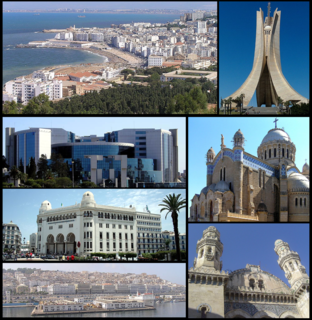
The Casbah is specifically the citadel of Algiers in Algeria and the traditional quarter clustered around it. In 1992, the United Nations Educational, Scientific and Cultural Organization (UNESCO) proclaimed Kasbah of Algiers a World Cultural Heritage site, as "There are the remains of the citadel, old mosques and Ottoman-style palaces as well as the remains of a traditional urban structure associated with a deep-rooted sense of community."
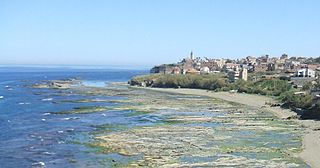
Dellys is a small Mediterranean town in northern Algeria's coastal Boumerdès Province, almost due north of Tizi-Ouzou and just east of the river Sebaou.
Dr. Abbassi Madani was born 28 February 1931 at Diyar Ben Aissa, Sidi Okba. He was the President of the Islamic Salvation Front in Algeria. As its leader he became the voice of a large part of the dispossessed Algerian youth.
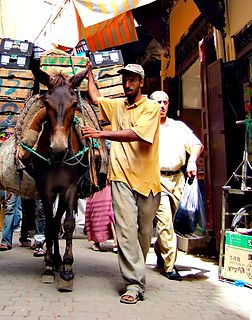
A medina quarter is a distinct city section found in a number of North African and Maltese cities. A medina is typically walled, with many narrow and maze-like streets. The word "medina" itself simply means "city" or "town" in modern-day Arabic although it was borrowed from an Aramaic-Hebrew word referring to a city or populated area.

A kasbah is a type of medina or fortress (citadel). The meaning of the word kasbah is varied, including keep, old city and watchtower or blockhouse.

Algiers is a 1938 American drama film directed by John Cromwell and starring Charles Boyer, Sigrid Gurie, and Hedy Lamarr. Written by John Howard Lawson, the film is about a notorious French jewel thief hiding in the labyrinthine native quarter of Algiers known as the Casbah. Feeling imprisoned by his self-imposed exile, he is drawn out of hiding by a beautiful French tourist who reminds him of happier times in Paris. The Walter Wanger production was a remake of the successful 1937 French film Pépé le Moko, which derived its plot from the Henri La Barthe novel of the same name.
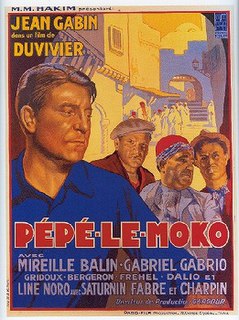
Pépé le Moko[pe.pe lə mo.ko] is a 1937 French film directed by Julien Duvivier and starring Jean Gabin.

The coat of arms of Algiers, the capital of Algeria, was created after the country's independence, it shows a fortress, which symbolizes the Casbah, and a boat which symbolize the Algerian fleet, vital to the country's economy in older times, as well as two lions, which can be seen in Bab Azzoun, one of the gates of the city. The crescent symbolizes Islam, the state religion, the feather to symbolize scientific and cultural development. The sheaf of corn symbolizes agriculture, while the wheel symbolizes industry.

The Ketchaoua Mosque is a mosque in Algiers, the capital of Algeria. It was built during the Ottoman rule in the 17th century and is located at the foot of the Casbah, which is a UNESCO World Heritage Site. The mosque that stands on the first of the Casbah’s many steep stairways, was logistically and symbolically the cynosure of the pre-colonial city of Algiers. The mosque is noted for its unique fusion of Moorish and Byzantine architecture.
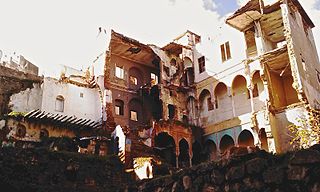
The Battle of Algiers was a campaign of urban guerrilla warfare carried out by the National Liberation Front (FLN) against the French Algerian authorities from late 1956 to late 1957. The conflict began as a series of terrorist attacks by the FLN against the French forces and civilians in Algiers, reprisals followed and the violence escalated leading the French Governor-General to deploy the French Army in Algiers to suppress the FLN. Civilian authorities left all prerogatives to General Jacques Massu who, operating outside legal frameworks between January and September 1957, successfully eliminated the FLN from Algiers. The use of torture, forced disappearances and illegal executions by the French later caused controversy in France.
A casbah, or kasbah, or Qassabah, is a unique kind of medina or fortress.

Icosium was a Punic and Berber city, a Roman colony, and an early medieval bishopric in the casbah area of Algiers..

Algeria is the largest country on the African continent and the 10th largest country in terms of total area. Located in North Africa, one of the main tourist attractions is the Sahara, the second largest desert in the world. Some sand dunes can reach 180 meters in height. Algeria has been a member of the World Tourism Organization since 1976. According to a report of the World Tourism Organization published in 2014, Algeria is the 4th largest tourist destination in Africa in 2013 with 2,7 million foreign tourists, and ranks 111th on the international tourism scene, according to the London-based World Tourism and Travel Council (WTTC). The tourism sector in Algeria accounts for 3.9% of the volume of exports, 9.5% of the productive investment rate and 8.1% of the Gross Domestic Product.
Abu Faris abd al-Aziz al-Maghrawi was a Moroccan poet and the first known author of a qasida written in malhun. He was one of the poets of the court of the Saadian sultan Ahmad al-Mansur (1578–1602). He is still well known in Morocco. His name is preserved in the proverb "Nothing that is long is of interest except the palmtree and al-Maghrawi". One of his best known poems is "Chafett Aïni Ya Raoui".

Hadj Bouchiba was an Algerian songwriter, lyricist, composer, poet and painter.
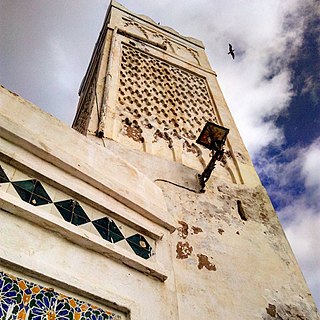
Sidi Ramadan Mosque is a historic mosque in the city of Algiers. Founded in 1097, the mosque is located in the Casbah of Algiers. It has an area size of 400 square meters and the minaret reaches 32 meters high. The mosque is a part of the UNESCO World Heritage Site Casbah of Algiers.

Ali Bitchin Mosque or Zawj Euyun Mosque is a historic mosque in Algiers, Algeria. The mosque is situated inside the UNESCO World Heritage Site Casbah of Algiers. It is located at the crosspoint between the Bab al-Wadi Street and the lower area of casbah.

The Casbah of Dellys is a historic kasbah or medina quarter, the old town in the city of Dellys, Algeria. The kasbah is known for Ottoman-era buildings and cityscape. Today it is a favorite spot for tourism in Boumerdès Province.
The architecture of Algeria encompases a diverse history influenced by a number of internal and external forces, including the Roman Empire, Muslim conquest of the Maghreb, French colonization, and movements for Algerian independence.


